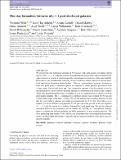The star formation histories of z ∼ 1 post-starburst galaxies
Abstract
We present the star formation histories of 39 galaxies with high-quality rest-frame optical spectra at 0.5 <z <1.3 selected to have strong Balmer absorption lines and/or Balmer break, and compare to a sample of spectroscopically selected quiescent galaxies at the same redshift. Photometric selection identifies a majority of objects that have clear evidence for a recent short-lived burst of star formation within the last 1.5 Gyr, i.e. 'post-starburst' galaxies, however we show that good quality continuum spectra are required to obtain physical parameters such as burst mass fraction and burst age. Dust attenuation appears to be the primary cause for misidentification of post-starburst galaxies, leading to contamination in spectroscopic samples where only the [O II] emission line is available, as well as a small fraction of objects lost from photometric samples. The 31 confirmed post-starburst galaxies have formed 40-90 per cent of their stellar mass in the last1-1.5 Gyr. We use the derived star formation histories to find that the post-starburst galaxies are visible photometrically for 0.5-1 Gyr. This allows us to update a previous analysis to suggest that 25-50 per cent of the growth of the red sequence at z ∼ 1 could be caused by a starburst followed by rapid quenching. We use the inferred maximum historical star formation rates of several 100-1000 M⊙yr-1 and updated visibility times to confirm that sub-mm galaxies are likely progenitors of post-starburst galaxies. The short quenching time-scales of 100-200 Myr are consistent with cosmological hydrodynamic models in which rapid quenching is caused by the mechanical expulsion of gas due to an acive galactic neucleus.
Citation
Wild , V , Taj Aldeen , L , Carnall , A , Maltby , D , Almaini , O , Werle , A , Wilkinson , A , Rowlands , K , Bolzonella , M , Castellano , M , Gargiulo , A , McLure , R , Pentericci , L & Pozzetti , L 2020 , ' The star formation histories of z ∼ 1 post-starburst galaxies ' , Monthly Notices of the Royal Astronomical Society , vol. 494 , no. 1 , pp. 529-548 . https://doi.org/10.1093/mnras/staa674
Publication
Monthly Notices of the Royal Astronomical Society
Status
Peer reviewed
ISSN
0035-8711Type
Journal article
Description
Funding: LTA acknowledges support from the Ministry of Higher Education and Scientific Research (MOHESR), Iraq. AW acknowledges financial support from the Royal Society Newton Fund (grant NAF/R1/180403, PI Natalia Vale Asari) and Fundação de à Amparo Pesquisa do Estado de São Paulo (FAPESP) process number 2019/01768-6.Collections
Items in the St Andrews Research Repository are protected by copyright, with all rights reserved, unless otherwise indicated.
Related items
Showing items related by title, author, creator and subject.
-
SDSS-IV MaNGA: How the stellar populations of passive central galaxies depend on stellar and halo mass
Oyarzún, Grecco A.; Bundy, Kevin; Westfall, Kyle B.; Tinker, Jeremy L.; Belfiore, Francesco; Argudo-Fernández, Maria; Zheng, Zheng; Conroy, Charlie; Masters, Karen L.; Wake, David; Law, David R.; McDermid, Richard M.; Aragón-Salamanca, Alfonso; Parikh, Taniya; Yan, Renbin; Bershady, Matthew; Sánchez, Sebastián F.; Andrews, Brett H.; Fernández-Trincado, José G.; Lane, Richard R.; Bizyaev, D.; Boardman, Nicholas Fraser; Lacerna, Ivan; Brownstein, J. R.; Drory, Niv; Zhang, Kai (2022-07-06) - Journal articleWe analyze spatially resolved and co-added SDSS-IV MaNGA spectra with signal-to-noise ratio ∼100 from 2200 passive central galaxies (z ∼ 0.05) to understand how central galaxy assembly depends on stellar mass (M*) and halo ... -
Secular-and merger-built bulges in barred galaxies
Mendez Abreu, Jairo; Debattista, V. P.; Corsini, E. M.; Aguerri, J. A. L. (2014-12) - Journal articleContext. Historically, galaxy bulges were thought to be single-component objects at the center of galaxies. However, this picture is now questioned since different bulge types with different formation paths, namely classical ... -
Galaxy And Mass Assembly (GAMA) : galaxy close pairs, mergers and the future fate of stellar mass
Robotham, A. S. G.; Driver, S. P.; Davies, L. J. M.; Hopkins, A. M.; Baldry, I. K.; Agius, N. K.; Bauer, A. E.; Bland-Hawthorn, J.; Brough, S.; Brown, M. J. I.; Cluver, M.; De Propris, R.; Drinkwater, M. J.; Holwerda, B. W.; Kelvin, L. S.; Lara-Lopez, M. A.; Liske, J.; Lopez-Sanchez, A. R.; Loveday, J.; Mahajan, S.; McNaught-Roberts, T.; Moffett, A.; Norberg, P.; Obreschkow, D.; Owers, M. S.; Penny, S. J.; Pimbblet, K.; Prescott, M.; Taylor, E. N.; van Kampen, E.; Wilkins, S. M. (2014-11-11) - Journal articleWe use a highly complete subset of the Galaxy And Mass Assembly II (GAMA-II) redshift sample to fully describe the stellar mass dependence of close pairs and mergers between 10(8) and 10(12)M(circle dot). Using the analytic ...

